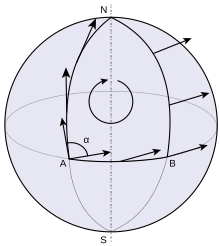Parallel transport
In the differential geometry referred parallel transport ( English transport parallel or parallel translation ) or parallel displacement of a method geometric objects along smooth curves in a manifold to transport. In 1917, Tullio Levi-Civita expanded Riemannian geometry to include this term, which then led to the definition of the context .
If the manifold has a covariant derivative (in the tangential bundle ), then vectors in the manifold can be transported along curves in such a way that they remain parallel with regard to the relationship belonging to the covariant derivative . Correspondingly, a parallel transport can be constructed for each context. A Cartan context even allows curves to be lifted from the manifold into the associated principal bundle . Such a curve lifting allows the parallel transport of reference systems, i.e. the transport of a base from one point to another. The parallel transport belonging to a connection thus allows in a certain way to move the local geometry of a manifold along a curve.
Just as a parallel transport can be constructed from a connection, conversely, a connection can be constructed from a parallel transport. In this respect, a connection is an infinitesimal analogue to a parallel transport or a parallel transport is the local realization of a connection. In addition to the local realization of a connection, a parallel transport also provides a local realization of the curvature , the holonomy . The set of Ambrose-Singer makes this relationship between curvature and holonomy explicitly.
Parallel vector field
Let be an interval and a differentiable manifold with connection .
A vector field along a curve is called parallel along if applies to all .
A vector field is said to be parallel if it is parallel with respect to every curve in the manifold.
Parallel transport
Let be a differentiable manifold, a curve and two real numbers. Then for each there is a unique parallel vector field along , so that holds. With the help of this statement of existence and uniqueness, one can define the mapping, which is called parallel transport : the mapping
which assigns its unique parallel vector field evaluated at the point to a vector .
The existence and uniqueness follow from the property of initial value problems of linear ordinary differential equation systems , the unique solution of which exists globally for all times according to the global version of Picard-Lindelof's theorem .
For the Levi-Civita context
The most important special case for the parallel transport is the transport of a tangential vector along a curve on a Riemannian manifold , the relationship being the Levi-Civita relationship .
In concrete terms: If a tangential vector is at the point and a smooth curve with , then a vector field is called along , i.e. H. with , and if and only then, parallel transport of , if:
so if the covariant derivative of along vanishes.
This is a linear initial value problem of the first order, of which the existence and uniqueness of a solution can be shown (see above).
The amount of a vector that is shifted in parallel is constant:
Along a geodesic
In the case of a geodesic , the parallel transport has special properties.
For example, the tangential vector of a geodetic parameterized proportionally to the arc length is itself parallel:
Because this was exactly the definition of a geodesic on a Riemannian manifold.
The angle between the tangential vector of the geodesic and the vector is constant, since the amounts of both vectors are also constant (see above).
In Euclidean spaces
In Euclidean space , the covariant derivative is the normal derivative in a certain direction. It disappears if , apart from the base point, is constant, i.e. i.e., if all vectors are parallel.
The parallel transport is therefore a generalization of the parallel displacement of a vector along a curve.
literature
- Christian Bär : Elementary Differential Geometry . 2nd Edition. De Gruyter, Berlin / New York 2010, ISBN 978-3-11-022458-0 .
- John M. Lee: Riemannian Manifolds. An Introduction to Curvature . 1st edition. Springer, New York / Berlin / Heidelberg 1997, ISBN 0-387-98322-8 .
- Manfredo do Carmo : Riemannian Geometry . 1st edition. Birkhäuser, Boston / Basel / Berlin 1992, ISBN 0-8176-3490-8 (Portuguese: Elementos de geometria diferencial . Rio de Janeiro 1971. Translated by Francis Flaherty, first edition: Ao Livro Técnico).
Individual evidence
- ^ Levi-Civita, Tullio . In: Guido Walz (Ed.): Lexicon of Mathematics . 1st edition. Spectrum Academic Publishing House, Mannheim / Heidelberg 2000, ISBN 3-8274-0439-8 .




























